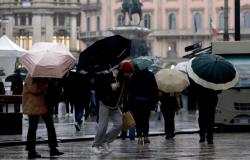A land of great historical, cultural and landscape richness, the island is among the destinations recommended by the nanopress travel portal. Here are the 10 places not to be missed
Sicily is one land of great historical richness, cultural and scenic, an unmissable destination for tourists. There are many magazines that indulge in recommending tours and itineraries around the beauties of the island.
Here is the top 10 places not to be missed for summer 2024 drawn up by the travel portal nanopress.
Etna
Etna is the beating heart of the island the highest active volcano in Europe.
It is located on the east side of the island, in the province of Catania, and is no less than 3329.6 meters high. Since 21 June 2013 “mother Etna” – as the inhabitants of the Etna capital call her – has been included in the List of World Heritage Sites.
The feminine name, according to some scholars, refers to a legendary anecdote which tells of a nymph bearing the name Etna.
Cefalù
On the coast, a destination not to be missed is Cefalù. The ancient one Kephalodion (in Greek “head”, referring to the conformation of the rock on which it stands), is one of the 15 Sicilian municipalities included in the Madonie Park.
Adv
This location offers all the ingredients for a relaxing beach holiday, among public and equipped beaches that unravel along a rich and uncontaminated beach.
The first stop is certainly the Giuseppe Giardina seafront. An evocative and picturesque, postcard-like spectacle, which extends for 1.5 kilometers of coastline.
A particularly vital beachequipped with umbrellas, bars and restaurants, where groups of young people gather at all hours for the town’s nightlife.
You can then enter the ancient town to get lost among the alleys and shops. In the historic center of the medieval city, among the monuments to visit, there is the Cathedral, behind it the Rocca, continuing the former Medieval Washhouse, the Porta Pescara and the Bastion.
Palermo
The magnificent Palermo lies on the Conca d’Oro, an area once cultivated exclusively with citrus plants, today, in particular, with the late Ciaculli mandarin. The origins of the city are very ancient, dating back to between the 7th and 6th centuries BC. C.
From the Norman Arab influence, to the Renaissance, the Baroque, the Art Nouveau and the Art Nouveau style: Palermo and its monuments testify to its role as a crossroads of peoples.
Among the places not to be missed in the historic center, nanopress recommends: la Cathedral which, since 2015, has been part of the World Heritage Site and the Palace of the Normansthe oldest royal residence in Europe, today the seat of the Sicilian Regional Assembly.
San Vito Lo Capo
Another place not to be missed is San Vito Lo Capo, where the Zingaro Nature Reserve is located. Here is a guide for a regenerating walk among the coves of the Reserve.
The crystalline, Caribbean sea, with a thousand shades of blue, makes the beach of San Vito Lo Capo one of the most beautiful places in western Sicily, and one of the most recommended destinations by tour operators.
Those arriving for the first time will not be able to help but be enchanted by the beauty of the gulf that suddenly opens up after the small hamlet of Castelluzzo, in the province of Trapani: an unparalleled blue, a sea landscape enclosed in a treasure chest of Mediterranean vegetation, where you can spend a holiday with family or friends between the sea and nightlife.
On the coast there are numerous restaurants where you can taste typical dishes.
Favignana
Taking the ferry you arrive in Favignana. Established in 1991, it is located about 7 km from the western coast of Sicily, between Trapani and Marsala, facing the Stagnone Islands.
This small island is part of the Egadi islands nature reserve and has some enchanting bays.
The name Favignana comes from Latin favonius (Favonio), term with which the Romans indicated the hot falling wind coming from the west. The village is located around a natural inlet where the port is structured, on whose banks there are the buildings of the ancient Florio tuna fisheries.
the Island is mainly covered by Mediterranean bush made up of bushy shrubs and Mediterranean pine forests. By renting a bicycle you can explore the characteristic village in complete relaxation.
Here is our guide to fully enjoy Favignana on two wheels.
Ragusa
Don’t miss one of the jewels of Sicilian baroque: Ragusa. The city is full of magnificent buildings and monuments such as the Portal of San Giorgio and the Cathedral.
The earthquake of 1693 marked the second life of the city, but Ragusa was reborn from the rubble, more beautiful than before, in the locations of upper Ragusa, with its churches, fortresses, and passages that rise vertically.
And then Ibla (in Sicilian “lusu”, or what lies below) which is a mirage of lights and shadows, with the central square being an open-air living room where time seems to have stopped.
Syracuse
Still to the south of the island you arrive in Syracuse. Known for its ancient ruins, it is a very fascinating city with its 2800 years of history.
The central Neapolis Archaeological Park contains the Roman amphitheater, the Greek Theater and the Ear of Dionysius, a cave dug into the limestone in the shape of a human ear.
Taormina
Among the stops recommended by nanopress there is also the beautiful Taormina.
Its theater is the second largest center of “classical” theatrical representation in Sicily, after the Greek Theater of Syracuse.
It was built by the Greeks, probably around the third century BC under the reign of Hiero II, manually removing over 100 thousand cubic meters of stone from the adjacent mountain.
It stands in a unique panoramic point, overlooking the Ionian Gulf and the mass of Etna. A few steps away there is also Isola Bella, the Pearl of the Mediterranean, a splendid green Nature Reserve with unique characteristics.
Known
Unmissable stop, Noto. Splendid village that stands on a plateau overlooking the Asinaro valley, it is a small jewel with very ancient origins, and an icon of Sicilian baroque.
An important Sicilian, Roman, Byzantine and then Arab centre, it was completely destroyed in its full splendor by the earthquake of 1693, but thanks to a meticulous reconstruction, Noto has become a magnificent city of art.
In 2002 its historic center was declared UNESCO heritagetogether with Caltagirone, Militello, Catania, Modica, Palazzolo, Ragusa and Scicli.
Agrigento
Known for the ruins of the ancient city of Akragas and the Valley of the Temples, a vast archaeological site with well-preserved Greek temples.
On the outskirts of the modern city is the Regional Archaeological Museum of Agrigento which houses artefacts and a Telamon. To the west, there is the Scala dei Turchi, an unusual white cliff with steps that overlooks sandy beaches.
The name of the place is to be attributed to the past piracy raids by the Saracens, Arab and, by convention, Turkish people. The Turkish pirates, in fact, found shelter in this area less affected by the winds and representing a safer landing place.
Tags: unique places missed summer





